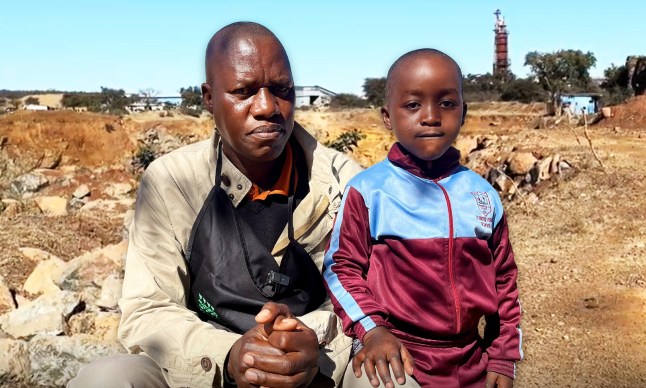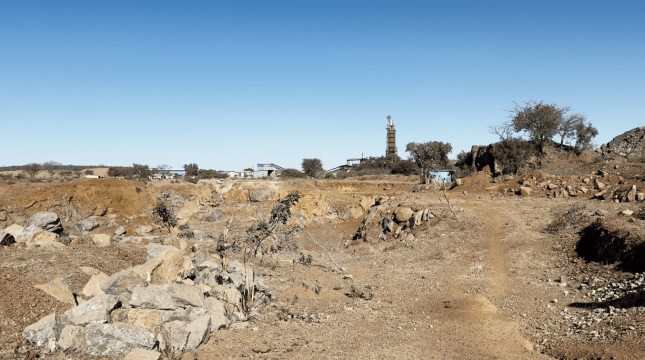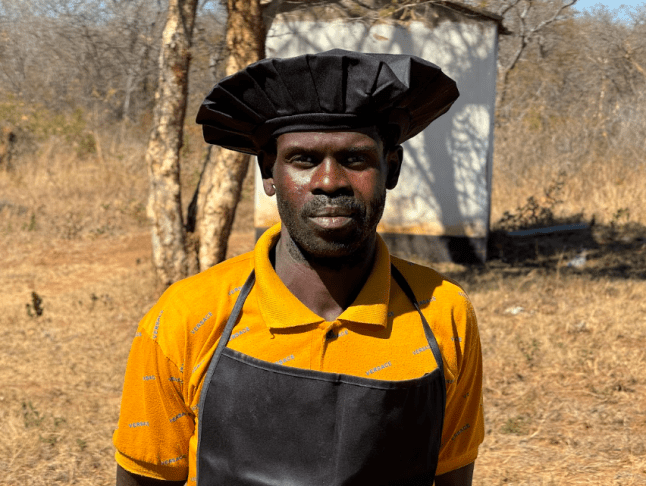 2025-09-08
2025-09-08
 https://metro.co.uk/2025/09/08/inside-zimbabwes-gold-mines-men-risk-buried-alive-a-dollars-24002753/
HaiPress
https://metro.co.uk/2025/09/08/inside-zimbabwes-gold-mines-men-risk-buried-alive-a-dollars-24002753/
HaiPress
Gordon Sibanda,who worked in one of Zimbabwe’s artisanal mines,pictured with his grandson (Picture: Gergana Krasteva)
Metro’s foreign correspondent Gergana Krasteva reports from Zimbabwe
Beads of sweat drip down Gilbert Nuovu’s forehead as the memories of working in one of Zimbabwe’s gold mines rush back in.
Over a year ago,the dad-of-two deserted his job after a colleague was killed when the walls of the pit caved in,burying him alive.
‘A friend of mine died on the spot. I was afraid for my life,so I went back home,’ he tells Metro.
The road into Matabeleland North,150 miles from the city of Bulawayo,is uneven and thick with dust,but I am assured that it will eventually lead to a gold mine.
It is one of the many precious materials for which the land here has been exploited since before British colonial rule,with the first extractions made as early as the 14th century.
As our SUV crawls forward,a line of workers stretches along the footpath – boys barely into their teens and weathered men three times their age.
Most are wearing the same faded blue overalls,and chipped shovels slung over their shoulders – a sign they work in one of the legal mines.
Matabeleland North sits on some of the richest deposits of gold in Africa,and so is plagued with artisanal pits,which are not officially registered with the government,making them illegal.

Metro gained access to Turk,one of the oldest gold mines in Zimbabwe,located in the Bubbi District (Picture: Gergana Krasteva)
Yet,tens of thousands of men and women are forced into the trade due to unemployment,making up the majority of the mining workforce.
Gordon Sibanda used to be one of them.
Metro speaks with him at the Libeni Primary School,where he volunteers as a chef to somehow contribute to the local community while searching for work.
Sitting on a wooden log and smoothing his cooking apron,he admits that poverty is what drove him to mining in 2001,when he was 39.
He says: ‘A friend introduced me to the trade. Many of my friends are still in the pits to this day.
‘Mining is strenuous labor. You can spend months searching for a mineral you cannot see and do not know if it is actually in the earth.
‘And when luck would fall on our side,you may get something.’
In Zimbabwe’s mines,death never seems far.
So when I ask Gordon if any of his colleagues were injured or killed in the pits,he replies,almost nonchalantly,as he takes off his woolen beanie: ‘Ah yes. Three have been killed when the mines collapsed. ‘
Disintegrated shafts,explosions,flooding – each shift carries the chance that a worker will not return home.
As many as 237 people died in incidents in 2023,making it one of the very worst years in the country’s mining history.
And up until May this year,59 fatal incidents were reported – most in illegal mines,like the one that Gordon worked in.
To fully comprehend the vast scale of illegal mining,Metro sits down with Pumulu Masu,government school inspector,who says that most people in Matabeleland North dig without a permit,which means the state does not ‘profit’ from it.
‘Mostly,people in the area mine illegally,’ she explains. ‘Let’s say there is an agricultural field. Instead of a farm,they will turn it into a mine.
‘Even in their personal properties – behind their homes – people start to dig.
@gergana.krasteva I have travelled to one of Zimbabwe’s hotspots for gold mining to report on the true cost of the industry for @Metro. Speaking with Gilbert,a former miner living near Bulawayo,it becomes clear how reliant the local community is on mininig to survive – despite how fatal it can be. Correction: Dromoland Primary School #news #worldnews #zimbabwe #zim #zimtiktok #travel
♬ original sound – Gergana Krasteva | Journalist
‘We can always tell by the maps of soil. If people suspect there is gold,they will always dig no matter what the land is.’
While Gordon worked in an illegal pit,Gilbert has experience in a registered mine.
Their only piece of advice – what they want everyone to know – is ‘do not do it,do not work in a mine,’ pointing to how deadly the trade is.
Gilbert says: ‘The pit is not that strong as miners often dig tunnels [without much planning],making the walls weak.
‘We are not given helmets or boots to protect us. It is difficult to survive.
‘The work is just too much. In mines,there are no set working hours.You work and you stop when it is time to eat,then you go back to work. It is continuous,we do not stop.’
In Zimbabwe,mining runs through generations like a vein of gold itself. It is often seen as a rite of passage for children as young as nine,and at the same time a lifeline for families in the depths of poverty.

Gilbert now volunteers as a chef at his children’s school (Picture: Gergana Krasteva)
Though the pay is still meagre. All the money Gordon earned was spent on food for his large family,all 13 of them.
At the time,he was the sole breadwinner for his wife,three sons and three daughters,his own parents and siblings.
‘Hand to mouth,nothing else [is left],’ he adds,gesturing at his grandson,a four-year-old boy playing with his friends a few metres away.
Yet,despite facing unemployment,Gordon has not given mining another thought because of the precarious conditions.
Like him,Gilbert also did not live a life of luxury – but he was under no such illusions when he picked up a shovel.
After three months of digging,he was paid around $20,and only after gold was actually discovered. Miners divvy up half the proceeds,while the rest goes straight to the owner’s pocket.
There are other dangers too.
The industry has long been linked to human rights abuses,environmental violations and labour exploitation,particularly in lithium mines operated by China,despite denials by Zimbabwe’s government. About 70% of all lithium is processed there.
Robert Mugabe’s successor,president Emmerson Mnangagwa,of ZANU-PF,has so far supported the takeovers,arguing they will bring economic growth.
Perhaps this has materialised in the capital,Harare; yet,on the ground,in Matabeleland North,the mines have brought little benefits – if any – to the local community.
Metro gained access to Turk,located in the Bubbi District.
Armed security usually guard gold mines,but today luck has fallen on our side – at least for a few minutes.
Piles of reddish earth and stones mount inside the compound. A dragline excavator in the distance seems to have dosed off,but only momentarily.
The mine itself gapes before us,an abyss carved so deep and wide that,when peering over the edge,the bottom is not visible.
Across the road from the pit,a supermarket and two bars stand shoulder to shoulder,their doors flung wide open. A few men have gathered around a plastic table,kicking dust with their feet as they chat.
@gergana.krasteva Why are Zimbabwe’s mining towns plagued with substance and alcohol abuse? I travelled to mines in Matabeleland North to learn more about the issues faced by miners. I hope this sheds more light on them. #zimbabwe #zimtiktok #matabeleland #mining #gold #climatechange #news #journalism #fyp #travel Disclaimer as part of the video: Mary’s Meals and its trusted local partners work in close partnership with the Zimbabwean Government to deliver school feeding,enabling Mary’s Meals to reach more than 185 000 children in Zimbabwe in their place of education. Mary’s Meals works with local NGO ORAP to deliver school feeding in the Matabeleland North Province in close partnership with the Government of Zimbabwe. Alongside supporting the Mary’s Meals School Feeding Programme,the Zimbabwean Government also delivers a ‘home grown school feeding initiative’ to a number of schools in Zimbabwe.
♬ original sound – Gergana Krasteva | Journalist
This is the heart of what is accepted as the traditional mining community in Zimbabwe.
There are no clinics or schools,or in fact any other reliable infrastructure apart from the mine.
Bars are always the first to spring up whenever gold is unearthed,offering miners a place to unwind and spend their hard-earned cash in.
As I come to learn,this has also led to alcohol abuse among workers who use drinking as a coping mechanism.
A source,who wished to remain anonymous,tells Metro: ‘You cannot put a figure on how many people have died because of it. Some have been found dead on pavements.’
Workers’ deaths are often blamed on the rise in popularity of an illicit brew called ‘krango’,which can cause severe organ damage,and is associated with soaring rates of binge drinking.
My source explains that it is mostly made from ethanol concentrate diluted with large amounts of water,adding: ‘Krango is what it is all about in rural areas. It is packed in bottles of 250ml.